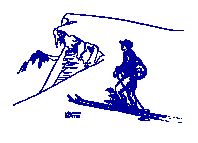
|
At 11.949 feet, Mt. Jefferson is the highest peak in Central Nevada. It is located in the Toyabe National Forest just to the north of Tonapah, Nevada. Skiing in Nevada is not a sure thing since often the snowfall is minimal for an entire season. The Sierra Nevada effectively blocks much of the moisture heading east. However, the snowfall in the Spring of 1995 was abundant and the ski season extended through April. On 13 April 1995, I drove almost 400 miles from L.A. to Tonapah to meet Armando Menocal who was driving from the Tahoe area. As I approached Tonapah, I encountered an icy storm with high winds that shut off the power in Tonapah. I wasn't sure that I would be able to continue on to Pine Creek Campground that night where I had arranged to meet Armando. I gave it a try and covered most of the remaining 80 mile drive before 1 parked and slept in my van. I continued on in the morning and found Armando at the campground at 7,500 feet. He also had weather stories to tell having barely been able to cross a high pass in the storm the previous evening. We started walking west from the campground at 9:30 a.m as light snow flurries were falling. Our plan was to ski a 2 day loop going up Pine Creek Canyon and returning via Bucks Canyon to our starting point. On the way, we hoped to ski all 3 of the summits of Mt. Jefferson. The trail we were following forced us to cross the adjacent Pine Creek 8 times before we were able to put on our skis and continue up the steep canyon. We had a difficult time locating ourselves on our map since we had taken a wrong turn at a lower junction. We finally camped on a high ridge at 11,000 feet, just east of the south summit of Mt. Jefferson. It snowed during the night and we wondered about avalanche problems on the steep slope we would ski in the morning. However, the morning was bright and sunny and the small amount of new snow did not pose a problem. At the summit, we found various research equipment powered by solar panels used for reasons we did not know. An archeological site was discovered near here in 1978 which is apparently the highest known Indian village in North America. |
We turned north and followed a high snow covered plateau that extended for 6 miles. Both the central and north summits were but small bumps on this high area. To the west, we could see the Arc Dome Wilderness where we skied earlier this year in February. Dropping down into Bucks Canyon turned out to very steep requiring us to kick steps for 100 feet using our self arrest poles to great advantage. Lower down in the canyon, the snow was excellent. We skied through a forest of Aspen-like trees and had great fun weaving our way through the obstacles. Looking ahead, Bucks Creek dropped into a deep, narrow canyon which hinted of a serious bushwhack. We traversed south to avoid this, intersecting Pine Creek once again and skied out to the campground following our entry route. (Yes, the 8 stream crossings were still there). We spent the night at the campground as it again snowed much of the night. In the morning, conditions did not look any better. We had planned to do a second 2-day loop in the Monitor Range across the valley to the east, but the storm looked very consistent and wet. We headed for home, postponing the Monitor trip until next year when we will return to Nevada for more obscure ski trips. Back to Rich's Reports Back to Trip Reports Back to SMS Home Page |